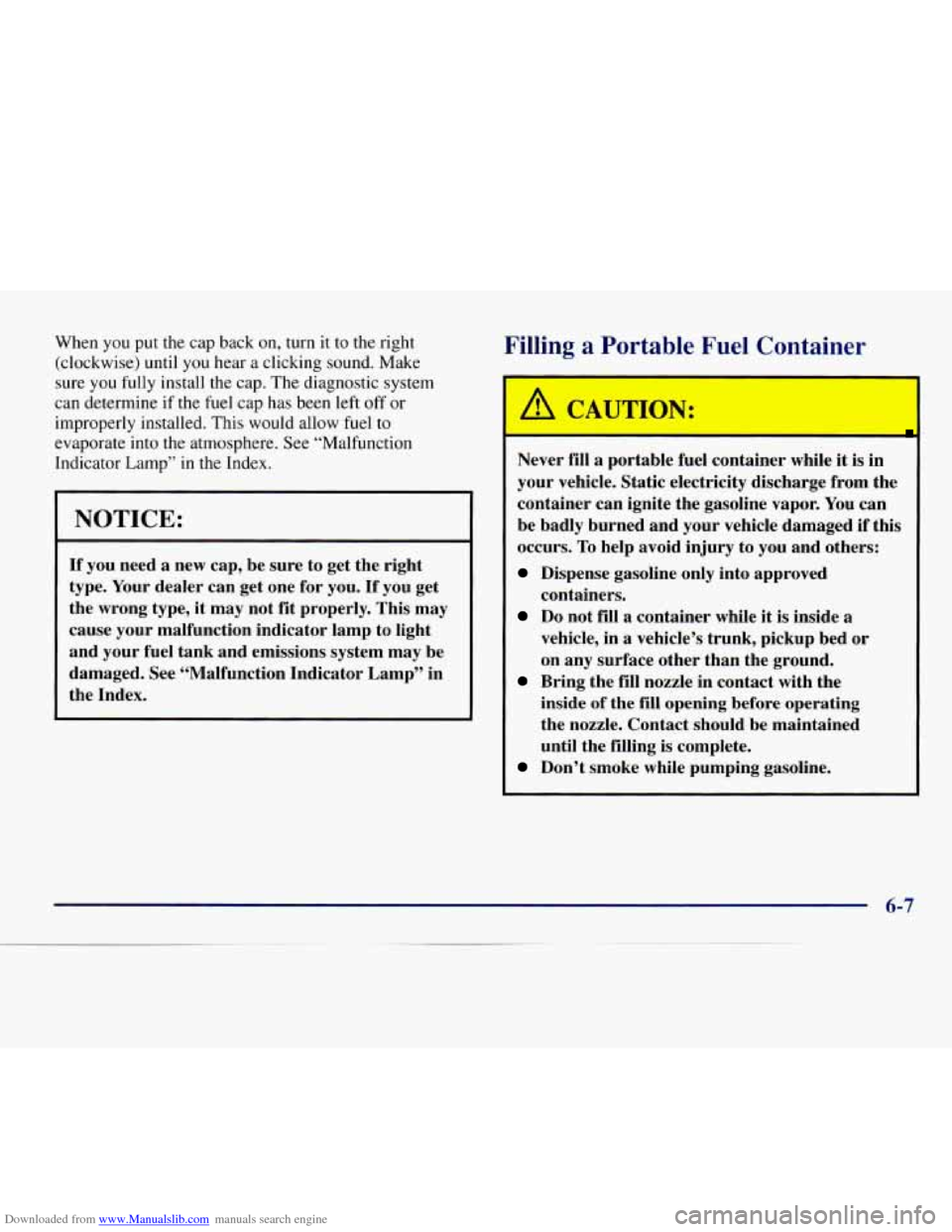Page 243 of 386

Downloaded from www.Manualslib.com manuals search engine If your vehicle is certified to meet California Emission
1 Standards (inhcated on the underhood emission control
label), it is designed to operate on fuels that meet
California specifications.
If such fuels are not available
in states adopting California emissions standards, your
vehicle
will operate satisfactorily on fuels meeting
federal specifications, but emission control system
performance may be affected. The malfunction indicator
lamp on your instrument panel may
turn on andor your
vehicle may fail a smog-check test. If this occurs,
return
to your authorized GM dealer for diagnosis to determine
the cause of failure. In the event it is. determined that the
1 cause of the condition is the type of fuels used, repairs
, may not be covered by your warranty.
Some gasolines that are not reformulated for low
emissions contain an octane-enhancing additive called
methylcyclopentadienyl manganese tricarbonyl (MMT);
ask your service station operator whether
or not his fuel
contains MMT. General Motors does not recommend the
use of such gasolines.
If fuels containing MMT are used,
~ spark plug life may be reduced and your emission
control system performance may be affected. The
malfunction indicator lamp on your instrument panel
may
turn on. If this occurs, return to your authorized
GM dealer for service.
~
i
To provide cleaner air, all gasolines in the United States
are now required to contain additives that will help
prevent deposits from forming in your engine and fuel
system, allowing your emission control system to
function properly. Therefore, you should not have to add
anything to the fuel. In addition, gasolines containing
oxygenates, such as ethers and ethanol, and
reformulated gasolines may be available in your area to
help clean the air. General Motors recommends that you
use these gasolines if they comply with the
specifications described earlier.
NOTICE:
Your vehicle was not designed for fuel that
contains methanol. Don’t .use it. It can corrode
metal parts in your fuel system and also damage
plastic and rubber parts. That damage wouldn’t
be covered under your warranty.
6-4
I
Page 246 of 386

Downloaded from www.Manualslib.com manuals search engine When you put the cap back on, turn it to the right
(clockwise) until you hear a clicking sound. Make
sure
you fully install the cap. The diagnostic system
can determine if the fuel
cap has been left off or
improperly installed. This would allow
fuel to
evaporate into the atmosphere. See “Malfunction
Indicator Lamp” in the Index.
NOTICE:
If you need a new cap, be sure to get the right
type. Your dealer can get one for you.
If you get
the wrong type, it may not fit properly. This may
cause your malfunction indicator lamp to light and your fuel tank and emissions system may be
damaged. See “Malfunction Indicator Lamp” in
the Index.
Filling a Portable Fuel Container
/i CAUTIOlr:
Never fill a portable fuel container while it is in
your vehicle. Static electricity discharge from the
container can ignite the gasoline vapor.
You can
be badly burned and your vehicle damaged if this
occurs.
To help avoid injury to you and others:
Dispense gasoline only into approved
containers.
Do not fill a container while it is inside a
vehicle, in a vehicle’s trunk, pickup bed or
on any surface other than the ground.
inside of the
fill opening before operating
the nozzle. Contact should be maintained
until the filling is complete.
Bring the fill nozzle in contact with the
Don’t smoke while pumping gasoline.
Page 306 of 386
Downloaded from www.Manualslib.com manuals search engine Capacities and Specifications
Replacement Parts
Replacement part numbers listed in this section are based on the latest information available at the time of printing,
and are subject to change. If a part listed in this manual is not the same as the part used
in your vehicle when it was
built, or
if you have any questions, please contact your GM dealer.
These specifications are for information only. If you have any questions, see the service manual for the chassis or
refer to the body manufacturer’s publications.
Engine Identification -- Gasoline Engines
Engine “VORTEC” 4300 “VORTEC” 5000
Type V6 V8
VIN Code w M
Fuel System CSFI’ CSFI 1
lCentra1 Sequential Fuel Injection
2Sequential Fuel Injection
Wheel Nut Torque
MODEL TORQUE
All 140 ft-lb (190 Nem)
“VORTEC” 5700
V8
R
CSFI’
“VORTEC” 7400
V8
J
SFI~
Page 308 of 386
Downloaded from www.Manualslib.com manuals search engine Fuel Tank Capacity (Approximate)
TYPE QUANTITY
Standard Tank 31 Gallons (117.33 L)
Standard Tank 33 Gallons (124.90 L)
Optional Tank* 55 Gallons (208.18 L)
** 159”, 177” Wheelbase Vehicles Only.
MODEL TYPE
Passenger and Cargo
Cab and Chassis
Cab and Chassis
Normal Maintenance Replacement Parts
Engine “VORTEC”4300 “VORTEC”5000
VIN W M
Oil Filter PF52 PF1218
Air Cleaner Filter
* A917C A9 17C
PCV Valve CV789C cv774c
Spark
Plugs 4 1-932 4 1-932
Fuel Filter GF48
1 GF48 1
Radiator Cap RC36 RC36
“VORTEC”5700
R
PF1218
A917C
cv774c 4 1-932
GF48
1
RC36
“VORTEC”7400
J
PF1218 A917C
cv774c 4 1-932
GF48
1
RC36
* Replace with AC Air Filter, Part No. A917C and for severe dusty conditions, use AC Air Filter, Part No. 1236C.